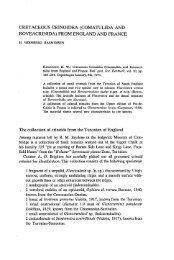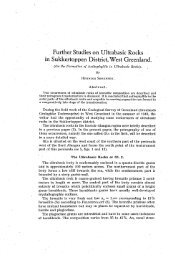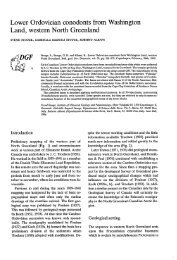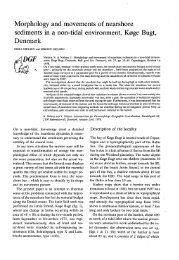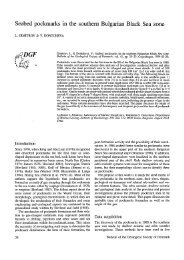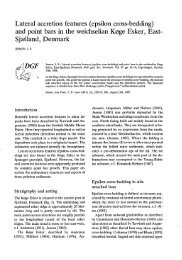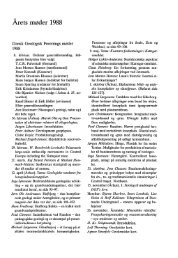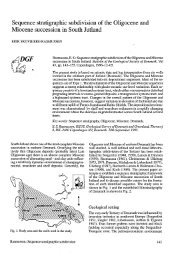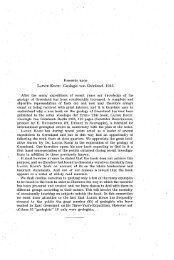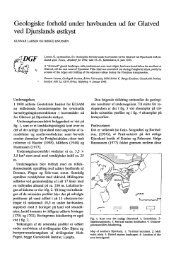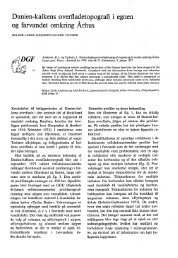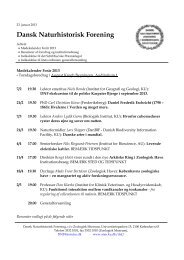Meddelelser fra Dansk Geologisk Forening 1953, bind 12, hæfte 3, s ...
Meddelelser fra Dansk Geologisk Forening 1953, bind 12, hæfte 3, s ...
Meddelelser fra Dansk Geologisk Forening 1953, bind 12, hæfte 3, s ...
Create successful ePaper yourself
Turn your PDF publications into a flip-book with our unique Google optimized e-Paper software.
Cretaceous Crinoidea.<br />
Preliminary report on the species found in Denmark.<br />
By<br />
H. WIENBERO RASMUSSEN.<br />
The study of Cretaceous crinoids in Denmark was continued by Dr.<br />
K. BRUNNICH NIELSEN after the publication of his monograph in 1913.<br />
On his death he left a large collection comprising several new species, and<br />
specimens giving new information about species already known. He also<br />
left notes which were to form the basis of a publication of these obeservations.<br />
The present writer has undertaken a restudy of this and other Danish<br />
collections, and it is his hope to extend the study also to Cretaceous<br />
crinoids from other areas, which he has so far mainly studied on the basis<br />
of literature and specimens in Danish collections.<br />
Since the study of these faunas cannot be finished within a short time<br />
the writer feels it to be of some value now to give a preliminary report<br />
oh some of the results and nomenclatorial corrections resulting from the<br />
study of the species found in Denmark (and Greenland). One new genus,<br />
Lipocrinus is established. The figures, descriptions and discussions will be<br />
given in the monograph. It is also the writers's hope that this report will<br />
be taken as an invitation to cooperate, so that no material or information<br />
of importance will be overlooked.<br />
The following information can be given on the species found in Denmark.<br />
Isocrinus carinatus (ROEMER), 1840. Synonymy: Pentacrinites agassizii HA-<br />
GENOW, 1840, and P. klodenii HAGENOW, 1840. ? Pentacrinites lanceolatus<br />
ROEMER, 1840 (indet.). (Priority of ROEMER 1840-41, part I 1840<br />
being published before HAGENOW 1840, cfr. W. RASMUSSEN 1950 p. 106).<br />
The species is known from Lower Maastrichtian in Denmark. Specimens<br />
from the Upper Maastrichtian in Denmark (Stevns Klint) belong to a<br />
closely related species or subspecies.<br />
/. fionicus (BR. NIELSEN), 1913. Complete calices are found. They show<br />
that the basalia are considerably smaller than in the reconstruction<br />
showed by BR. NIELSEN. The stems combined with I. longus belong to<br />
this species. Lectotype: NIELSEN pi. 8 fig. 49-51. L.-U. Danian.<br />
/. longus (BR. NIELSEN), 1913. Only one basal is known of this species, the<br />
stem belonging to L. fionicus. Lectotype: BR. NIELSEN pi. 8 fig. 7-11.<br />
U. Danian.<br />
/. obsoletus (BR. NIELSEN), 1913. Stem, calyx and proximal arm plates are<br />
known of this species. The stem was formerly connected with /. divergens.<br />
Lectotype: BR. NIELSEN pi. 10 fig. 4-8. U. Danian.<br />
28
416 R. WIKNBERG RASMUSSEN: Cretaceous Crinojdea.<br />
7. divergens (BR. NIELSEN), 1913. Radialia and primibrachialia known.<br />
The stems, or some of them, belong to 7. obsoletus. Lectotype: BR.<br />
NIELSEN pi. 9 fig. <strong>12</strong>-15. L.-U. Danian.<br />
7. campanularis (BR. NIELSEN), 1913. Only radialia known. L.-U. Danian.<br />
7. miliaris (BR. NIELSEN), 1913. Stem known, nodal joints being also found.<br />
There are less than five (1-3) large cirri attached to the outer surface<br />
of each nodal joint. Lectotype: BR. NIELSEN pi. 9 fig. 47-48. L. Danian.<br />
7. convexus (BR. NIELSEN), 1913. Stem known, nodal joints being also<br />
found. There are less than five (1-3) small cirri attached to the outer<br />
i surface of each nodal joint. U. Danian.<br />
7. n. sp. 1. (aff. carinatus). U. Maastrichtian.<br />
7. n. sp. 2. L. Maastrichtian.<br />
7. n. sp. 3. U. Danian.<br />
7. rejstrupianus (BR. NIELSEN), 1913. Synonym: Pentacrinus kagstrupia-<br />
\ nus BR. NIELSEN, 1913. These two types are now known from the same<br />
I zones of the Danian. Some of the differences are due to incorrectness of<br />
I the figures. The same, or a closely related species, is found in the Seno-<br />
: nian. This species is not, as presumed by SIEVERTS-DORECK on the basis<br />
I of the figures, closely related to Metacrinus. The axial canal does not<br />
: branch until within the radialia and does not come out on the upper<br />
;' side of the basal, but on the outer surface. The radialia have been not<br />
i above but outside the basalia covering a part of these. The uncovered<br />
\ lateral part of the basal is more or less granulated. The structure of this<br />
j calyx is thus in some degree similar to Liassic Pentacrinidae. ?Senonian.<br />
| L.-U. Danian.<br />
Austinocrinus bicoronatus(HAGENOW), 1840. Synonymy: A. rothpletzi STOL-<br />
| LEY, 1892. A. meyni STOLLEY, 1892. A. zilteli STOLLEY, 1892. Ilsocrinus<br />
\ holsaticus JAEKEL, 1904: The figures and information given by STOLLEY<br />
I 1892 indicate the identity of these species of Austinocrinus, and the same<br />
I opinion is a result of a study of specimens from Lagerdorff and Møn.<br />
i The few stem joints found at Møn (Campanian or L. Maastrichtian) show<br />
i both the bicoronatus and the rothpletzi form. 7. holsaticus is found at a<br />
\ locality where A. bicoronatus is the dominating or only species of Pentai<br />
crinidae.<br />
Lipocrinus nov. gen. (AiW> prefix for kelnetv to leave or omit: referring<br />
! to the alternicirrate character).<br />
j Genotype.—Pentacrinus subbasaltiformis SOWERBY, in WETHERELL<br />
; 1840. Diagnosis.—Stem pentagonal or pentalobate to cylindrical. Jointi<br />
faces show an ornament varying form that typical of Balanocrinus to<br />
i more or less like Isocrinus. Nodal joint with less than five cirri attached<br />
I to the lower edge of the joint. Basalia rather small. I Br 1-2 and II Br<br />
i 1-2 are synostoic. I Br 2 is axillary.<br />
Species.—Among the species belonging to this genus are:<br />
Miocene: L. cubensis (VALETTE), in Rom 1926. L. lorioli (NOELLI), 1900.<br />
L. hailiensis (SPRINGER), 1925.<br />
Oligocene: L. dollini (TERMIER), 1949.<br />
Eocene: L. subbasaltiformis (SOWERBY), 1840. L. didaclylus (ARCHIAC),
Medd, <strong>fra</strong> <strong>Dansk</strong> Geol. <strong>Forening</strong>. København. Bd. <strong>12</strong>. [<strong>1953</strong>]. 417<br />
1846. L. n. sp. (SIEVERTS-DORECK 1944 p. 138: B. subbasaltiformis, Denmark).<br />
L. buchii (ROEMER), 1840. Synonymy: Pentacrinites buchii HAGENOW, in<br />
ROEMER 1840. Pentacrinites bronnii HAGENOW, 1840. Pentacrinus peroni<br />
LORIOL, in PERON 1889. Balanocrinus africanus LORIOL, in PERON<br />
1889. As in'the case of I. carinatus this species was first published by<br />
ROEMER. He mentions HAGENOW as the author, no doubt referring to<br />
their correspondence. At any rate the description as well as the name is<br />
different from that given by HAQENOW himself later in 1840. ROEMER<br />
must therefore be taken as the author. Stem, calyx and proximal arm<br />
plates are found in Denmark. The calyx shows great resemblance to<br />
the calyx of /. holsaticus and L. paucicirrhus. U.'Senonian.<br />
L.- stelliferus (HAGENOW), 1840. (= P. stalliferus HAGENOW, in GEINITZ<br />
1888). This species was never figured, and has never since been mentioned.<br />
On basis of the description it is identified in Denmark. Stem, calyx<br />
and arms are found. U. Senonian.<br />
L. paucicirrhus paucicirrhus (BR. NIELSEN), 1913. Lectotype: BR. NIELSEN<br />
pi. 6 fig. 39-41. L. Danian.<br />
L. paucicirrhus crassus (BR. NIELSEN), 1913. II Br 2 seems not to be axillary.<br />
The differences between these two greatly varying subspecies are<br />
small and only found by statistical methods. There is found no regularity<br />
in the number of cirri (1-4) internodal joints (5-32) or in the alternation<br />
of cirri. Lectotype: BR. NIELSEN pi. 7 fig. 43-44. U. Danian.<br />
L. n. sp. Danian. West Greenland.<br />
Bourgueticrinus hagenowii (GOLDFUSS), 1840. Synonymy: B. verrucosus BR.<br />
NIELSEN, 1913. B. bulbiformis BR. NIELSEN, 1913. B. turris BR. NIELSEN<br />
1913. The specimens found in Denmark show very great variation, including,<br />
the aberrant forms here regarded as synonymous, and forms<br />
foreshadowing B. danicus and some of its variations. Calices in which<br />
the proximate is lost show a great resemblance to Mesocrinus suedicus<br />
CARPENTER, 1881. This species is most likely the basal and radial ring<br />
of one of the variable species B. hagenowii or B. elliplicus (MILLER),<br />
1821. The only specimen of Mesocrinus is thus the apparently pathological<br />
specimen which is the type of M. fischeri (GEINITZ), 1875. U. Senonian.<br />
B. danicus BR. NIELSEN, 1913. Synonym: B. curvatus BR. NIELSEN, 1913.<br />
In some cases fine sutures are seen separating the fused stem joints<br />
which form the proximale. The number of stem joints forming the proximale<br />
is from two to four. There is a great variation in the outline of<br />
the calices. Lectotype: BR. NIELSEN pi. 3 fig. 3-4. Danian.<br />
B. "Briinnichi Nielseni" ØDUM, 1923. This name is invalid, being trinominal.<br />
Several specimens are known, some of them apparently forming<br />
a transition from B. danicus or B. hagenowi. A valid name should not be<br />
introduced until the study of these forms is finished. Danian. ?Senonian.<br />
Democrinus maximus (BR. NIELSEN), 1915. A great number of specimens<br />
show the variation and ontogeny of this species. Lectotype: BR. NIELSEN<br />
fig. 1 a-c, the larger calyx. L.-U. Danian.<br />
•2.S*
418 R. WiF.NBERG RASMUSSEN: Cretaceous Crinoidea.<br />
Bathycrinus n. sp. Stem, calices and primibrachials are found of a species<br />
which can with certainty be referred to the genus Bathycrinus, and may<br />
only by detailed analysis of the dimensions be distinguished from living<br />
species. Danian.<br />
Rhizocrinus? dubius (BR. NIELSEN), 1913. A new and better preserved calyx<br />
of this species has been found. The affinity to Rhizocrinus or Democrinus<br />
is not yet solved. Senonian.<br />
Rhizocrinus ? spp. Three new species are known, one Senonian, one Danian<br />
and one Senonian-Danian. These strange species show some affinity to<br />
Rhizocrinus.<br />
Solanocrites danicus (BR. NIELSEN), 1913. Synonym: Glenotremites parvicavus<br />
GISLEN, 1924. G. parvicavus was based on the figure of a centrodorsal<br />
with a very narrow cavity. This figure, however, is not correct.<br />
BR. NIELSEN pi. 11 fig. 4-6 apparently belong to C. semiglobularis. It<br />
seems more natural to include this species in the present genus than in<br />
Palaeantedon. Lectotype: BR. NIELSEN pi. 11 fig. 1-3. The name Solanocrinus<br />
is a junior synonym of Solanocrinites GOLDFUSS, 1831. (In the<br />
same way Pentacrinus is a synonym of Pentacrinites BLUMENBACII,<br />
1810)."Danian.<br />
S. graniilatus (BR. NIELSEN), 1913. This species, which was regarded by<br />
GISLEN as unidentifiable, is now represented by calices and proximal<br />
arm plates. It shows a close affinity to S. danicus. U. Danian.<br />
Amphorometra conoidea (GOLDFUSS), 1839. Synonymy: A. brydonei GIS<br />
LEN, 1924 .? Glenotremites parvus GISLÉN, 1924. ? A. alta GISLÉN, 1925.<br />
Senonian.<br />
Conometra semiglobularis (BR. NIELSEN), 1913. Also the radial ring is<br />
known of this species. BR. NIELSEN pi. <strong>12</strong> fig. 39-41 is possibly C? faxensis.<br />
Lectotype: BR. NIELSEN pi. <strong>12</strong> fig. 36-38. Danian.<br />
C? faxensis (BR. NIELSEN), 1913. Lectotype: BR. NIELSEN fig. 26 in the<br />
text. U, Danian.<br />
C? brunhichi (ROSENKRANZ), 1945. Uppermost Danian.<br />
Semiometra plana (BR. NIELSEN), 1913. Synonym: S. pommerania GISLÉN,<br />
1924. The radial ring was only known in Senonian specimens from British<br />
collections. The calices now found in the Danian combine characteristics<br />
of the British S. plana, and S. pommerania. The subspecies stellata<br />
GISLÉN, 1925, which can hardly be distinguished from S. impressa (CAR<br />
PENTER), 1881, is not found in Denmark. Senonian-Danian.<br />
Hertha cava (BR. NIELSEN), 1913. Synonym: Hertha suecica GISLÉN, 1924.<br />
Lectotype: BR. NIELSEN pi. 11 fig. 51-53. Danian.<br />
H. pygmea GISLÉN, 1924. Senonian.<br />
Cyathidium holopus BR. NIELSEN, 1913. The species seems not to have<br />
been validly established until 1913. The large triangular II Br 1 has on<br />
its inner side a groove with a side branch to an articular facet for the<br />
pinnule on the abaxial side of the inner surface. The main branch ends<br />
in an articular facet, not a syzygy, for II Br 2 a little above the middle<br />
of the plate. The impressions in the distal part of II Br 1 indicate the<br />
presence of at least 4 small distal secundibrachials which were completely<br />
covered by the II Br 1 when they closed the calyx. II Br 2 is distin-
Medd. <strong>fra</strong> <strong>Dansk</strong> Geol. <strong>Forening</strong>. København. Bd. <strong>12</strong>. [<strong>1953</strong>]. 419<br />
guished by the large ligament surface forming an angle with the muscular<br />
fossae. Lectotype: BR. NIELSEN pi. 4 fig. 7. U. Danian.<br />
BIBLIOGRAPHY<br />
BIESE, W. & H. SIEVERTS-DORECK. Crinoidea cretacea.—Fossilium Catalogus Pars<br />
77 & 88. 's-Gravenhage 1937 & 1939.<br />
RASMUSSEN, H. W. Cretaceous Asteroidea and Ophiuroidea with Special Reference to<br />
the Species Found in Denmark.—Danmarks Geol. Unders. II Rk. Nr. 77. København<br />
1950.<br />
SIEVERTS-DORECK, H. Zur Morphologie und systematischen Stellung von Balanocrinus.—Neues<br />
Jahrbuch Min., Abh. B. 88. Stuttgart 1944.<br />
— Uber Isocrinidea (Metacrinus-Verwandte) aus der Dånischen Kreide.— <strong>Meddelelser</strong><br />
<strong>Dansk</strong> Geol. Foren. Bd. <strong>12</strong>,1. Kobenhavn 1952.<br />
POSTSCRIPT<br />
A recent publication by SIEVERTS-DORECK, Mitteilungen Geol. Staatinst. Hamburg<br />
<strong>1953</strong>, shows that Austinocrinus bicoronalus is not found together with A.<br />
rothpletzi at Lågerdorf. These two species cannot therefore be identical. The species<br />
found in Denmark together with A. bicoronatas seems to be the variety of<br />
A. rothpletzi mentioned by SIEVERTS-DORECK.<br />
Færdig <strong>fra</strong> trykkeriet den 21. august <strong>1953</strong>.



